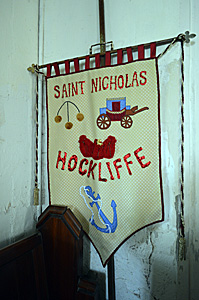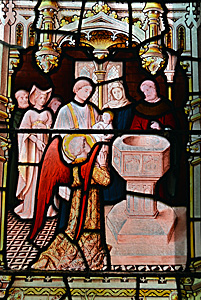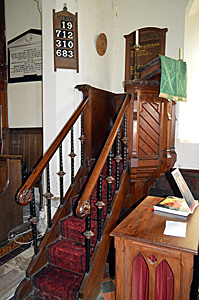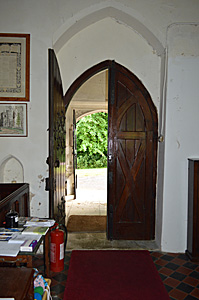List of Hockliffe Rectors

Church vexillum July 2015
Advowson
Volume III of the Victoria County History for Bedfordshire was published in 1912. It states that the advowson of Hockliffe church was attached to the Hospital of Saint John. The first known Rector was appointed to Hockliffe by the Hospital in 1218. The Master of the Hospital received a licence to impropriate the church in 1303-4, meaning that the Hospital received the income and appointed a priest to carry out the religious duties of the parish. In 1405/6 two presentations were made by King Henry IV (1399-1413), before reverting back to the Master of the Hospital at Hockliffe, which by 1422 had come under the control of Dunstable Priory. After Dunstable Priory were dissolved by King Henry VIII (1509-1547) in 1540 the advowson was exercised in 1541 by Master John Chambre MD "by grant to him and others from the late Prior and Convent of the dissolved Priory of Dunstable".
The advowson passed to the Crown and was subsequently granted to Kendrick Davis and others, who alienated the right to present to the rectory of Hockliffe to Roger Guise in 1566. From him it was passed to Thomas Sheppard and Edward Duncombe before coming into the possession of Robert Gilpin, who himself became Rector of Hockliffe in 1616. When he died in 1641 he left the patronage of Hockliffe Church to his wife Margery, with the instruction that it should be sold and £300 each be given to his daughters Katherine and Agnes from the proceeds. The advowson was bought by Katherine's husband, Hezekiah Slingsby, who succeeded his father-in-law as Rector. After her husband's death Katherine presented the living to her own son-in-law Adam Haughton, who was married to her daughter Rebecca. When she herself was widowed Rebecca herself excercised the right of presentation, first to her son Adam Haughton in 1687 and again in 1743. After this the advowson again reverted to the Gilpin family until 1822 when it was sold to a Mrs. Robinson. The valuation given in the sale catalogue for the "perpetual advowson" of the Rectory of Hockliffe with the Vicarage of Chalgrave was £485. It described the duties as "easy, once on a Sunday at each Church alternately, morning and afternoon" and the annual income for both parishes was £462. 12s. 0d after deductions for land tax [AD534/10]. The right of presentation to the parish was subsequently exercised by W. Prescott in 1841, F.H. Gray in 1870, the trustees of H. J. Spence Gray (late Archdeacon of Lahore) and Mrs. Gray.

Nave south window detail July 2015
List of Rectors of Hockliffe
- Nicholas of Luton, clerk: 1218;
- Thomas of Dunstable, chaplain:1227
- John de Pokelinton, chaplain: 1247
- William Malherbe;
- William de Pomerey, collated by the Bishop in place of William Malherbe, who had been elected by the Brethren of the Hospital of St. John the Baptist, Hockliffe to the parochial cure of Hockliffe church, but was rejected by the Bishop for defect of orders and insufficiency of learning: 11 May 1266;
- Martin;
- William Durand (or Durant), subdeacon, presented as a minor by the Master and Brethren of Hockliffe Hospital on the death of Martin, custody was given to John de Hemeng, Canon of Lincoln, until he came of age: 26 May 1285
- John de Kaynes, subdeacon, on the resignation of William Durant: 28 December 1316;
- John de Newenton;
- Walter de Groby, Vicar of Graveley in the Diocese of Ely, by exchange with John de Newenton: 5 May 1340;
- John de Wyndhull, on resignation of Water de Groby; 19 April 1350;
- John de Armeston;
- William Balyden, clerk, on the death of John de Armeston: 25 October 1379;
- Robert Johnson, primam tonsuram obtinens ('first obtaining the tonsure', meaning he needed to become a member of the clergy before his institution), on the resignation of William Balyden;
- Simon Taillour of Desborough [Northants] on the resignation of Robert Johnson: 27 November 1392;
- Richard Wystow
- Robert Aylesby, priest, on the resignation of Richard Wystow: 1 November 1399;
- John Hauberk;
- John Catryk, chaplain, on the resignation of John Hauberk, exchanged to be Rector of Ekton: 25 December 1401;
- Thomas Catryk, priest, on the death of "Roger" [sic] Catryk: 30 October 1405 [presented by King Henry IV ; "The King presented this vicar himself only because Dominus William atte Mylne the last Master of the Hospital of Hockliffe in the time when he stood as 'legate' to the church of Hockliffe had presented the aforesaid Roger"]
- John Freman, priest, on the resignation of Thomas Catryk: 11 Jan 1406;
- John Newport;
- John Barrns, priest, on the resignation of John Newport, exchanged to be Rector of Stanford Rivers [Essex]: 24 Mar 1454;
- Richard White, priest, on the resignation of John Barrns, exchanged to be Rector of Pertenhall: 3 Feb 1459;
- Thomas Person, priest, on the resignation of Richard White, by his will dated 4 October 1461 to be buried in Hockliffe churchyard: 30 May 1460;
- Richard Wardehalgh, priest, on the death of Thomas Person:29 Jan 1462;
- William Holand, priest, on the death of Richard Wardalgh: 1 Apr 1466;
- Roger Peret, on the resignation of William Holand, preferred to the Chantry of Chalgrave: 11 Apr 1477;
- Thomas Gyles, on the death of Roger Pyrot: 20 Nov 1482;
- Thomas Dichefeld, vicar of 'Northweld', dioceses of London (North Weald Bassett [Essex]?), on exchange with Thomas Gyles:16 May 1483;
- William Baynton, on the resignation of Thomas Dichefeld: 24 Nov 1484;
- Robert Smythe;
- Edmund Wingate, priest, on the death of Robert Smythe, instituted on 29 July 1491 to be Vicar of Weedon [Northants]: 6 Mar 1500
- John Markham, chaplain, on the death of Edmund Wingate: 18 Mar 1532;
- John Ashewell, doctor, on the death of John Markham:13 Feb 1536;
- John Amridge STB, on death of John Ashewell: 1 Apr 1541;
- Thomas Meygott: 24 Aug 1546;
- Peter Hadwen: 8 Mar 1553;
- Richard Palfreyman:19 Jun 1554;
- Lodovic Price, will proved in 1595; 2 Dec 1559;
- John Hanmer?;
- Thomas Bentham MA, buried 20 Feb 1615: 7 Jul 1595;
- Robert Gilpin BA, married Margery Johnson at Ridgmont 8 Jul 1624, will dated 17 Oct 1640 and proved 16 March 1641, buried 1 Feb 1641: 6 Jun 1616;
- Hezekiah Slingsby, clerk, buried 15 Jul 1663; will dated 23 Oct [sic], proved 1 Nov 1663: 27 Jun 1642;
- Thomas Power, clerk, on death of Hezekiah Slingsby, buried 10 Feb 1665: 18 Nov 1663;
- Robert Stackhouse, clerk, on death of Thomas Powers, married Catherine, daughter of Henry Slingsby at Houghton Conquest 1670 : 29 Mar 1666;
- Adam Haughton MA , on death of Robert Stackhouse, died 16 Apr 1713: 27 Sep 1687;
- Edward Hall AM, on death of Adam Haughton, died 7 May 1743: 7 Oct 1713;
- Adam Haughton AB, on cessation of Edward Hall: 25 May 1719;
- Walter Foot AM, on death of Adam Houghton, buried 4 Apr 1750: 29 Sep 1743;
- Thomas Walker, clerk, on death of Walter Foot, buried 26 Jan 1772: 22 Jun 1750;
- William Dodd LLD, on death of Thomas Walker, inducted 13 Feb 1775 to be Vicar of Wing [Buckinghamshire], son of William Dodd, Vicar of Bourne [Lincolnshire]; born 29 May 1729; of Clare College, Cambridge, BA 1749, MA 1759, LLD 1766; hanged at Newgate 27 Jun 1777 for forgery: 23 Mar 1772;
Rectors of both Chalgrave and Hockliffe after union of the two parishes in 1772:
- John Warner DD, on death of William Dodd: 19 Dec 1777;
- John Robinson , on cessation of John Warner, died 15 Feb 1842: 24 Mar 1791;
- John Stubbs Neumann MA, on death of John Robinson, resigned 30 Sep 1869; died at Bath 25 Feb 1904: 14 Apr 1842;
Rectors of Hockliffe following ending of the union with Chalgrave by an order of 1858:
- Frederick Henry Gray MA, on resignation of John Stubbs Neumann: 15 Oct 1869 [on resignation of John Stubbs Neumann;
- William Mason: Dec 1887;
- John William Kempe: Jul 1897;
- Thomas Barton Tatham: Jul 1904;
- William George Percival Ambrose Jacoby: Jan 1933;
- Fred Kettlewell: 1942;
- Frederick Watson: Jan 1949;
- John James Frank Scammell: 1980;
- Peter Harold Whittaker: 1981;
- John Anthony Lovett Hulbert:1992;
- Grant Fellows: 2003

Pulpit 2015
Visitations
Volume 81 published by the Bedfordshire Historical Records Society (2002) is devoted to returns made during episcopal visitations to the county by the Bishop of Lincoln in the early 18th century, edited by former County Archivist Patricia Bell. It throws some interesting light on non-residency and the general state of the church in the parish. At this date it was common for a rector or vicar to not live in the parish he nominally served, often because he had more than one, and so employed a curate to undertake their parochial duties for him. The returns for Hockliffe are as follows:
- 1706: the Rector and Patron was Mr. Adam Haughton. The parish consisted of about 30 families. The only dissenter was the schoolmaster, who was an Anabaptist. There were no Papists or reputed Papists.
- 1709: The Rector had been priested by the bishop of Lincoln on 23 January 1677 and instituted to the parish on 27 September 1687. The curate was Edward Hall of Leighton. There were 31 families and 160 souls, of whom two were Anabaptists. None were unbaptised, many were not confirmed, there were about 20 communicants of whom 14 had received the previous Easter. "There are too many who never communicate at all".
- 1712: There were 37 families, including one of Anabaptists. The [School]Master was an Anabaptist, but taught the Church Catechism. The Rector resided in the Parsonage House and the Curate lived at Leighton and had a stipend and perquisites of £20 a year. No unbaptized came to Church but some were not confirmed. Divine Service was held once every Lord's day, and catechizing took place every other Sunday for most of the year, with a great number attending which increased every year. Communion was given four times a year, with between 50 and 60 receiving (about 30 at a time). There had been no Pennance or Commutations since the last Visitation.
- 1717: Out of 45 families, two were Anabaptists with no other Dissenters. There were no meeting houses in the parish. The Rector resided in the Parsonage-house. None were unbaptised, to the Rectors knowledge although several were not confirmed. Divine Service was read in the Church on Wednesdays, Fridays, and Saturdays in the afternoon "Hay Time and Harvests excepted", and was performed twice every Sunday. The Rector, Edward Hall, catechized every Saturday afternoon except hay time and harvest, but many children were not sent to be instructed which was imputed to the neglect of the Schoolmaster, an Anabaptist, who did not instruct the children in the doctrine of the Church of England and did not bring them to Church. The Rector had given Lewis's exposition of the Church Catechism to all he could persuade to use it. He generally administered the Sacrament of the Lord's Supper eight times a year and there were between three and four score Communicants, with about 30 usually receiving. He gave "open and timely warning" of the Sacrament, parishioners did not send in their names and he had not refused the sacrament to anyone. No public penances had been imposed.
- 1720: There were now about 40 families, still with two of Anabaptists, and no meeting houses. There was no alms house, hospital or other charitable endowment besides the school. The Rector, now Adam Haughton, was resident in the Parsonage and he kept no Curate. He knew of no unbaptised parishioners. Public Service was performed twice a day, "somewhat after ten" in the morning and at two in the afternoon. He taught the Church Catechism from the first Sunday in Lent until Easter "and should continue it longer only the number is so very small, not exceeding three, and they not constant". The schoolmaster, as a Dissenter, did not take care to instruct the children in the Christian Religion or to bring them to Church. The Rector administered the Sacrament every quarter after giving a fortnight's warning, but the number of communicants was usually not above sixteen, with about twenty the previous Easter. No public penance had been performed in his time.

The south door July 2015
Ecclesiastical Census
On Sunday 30th March 1851 a census of all churches, chapels and preaching-houses of every denomination was undertaken in England and Wales. The local results were published by Bedfordshire Historical Records Society in 1975 as Volume 54, edited by D.W.Bushby. The return for Hockliffe church was made by the Rector, J. S. Neumann, who noted the following pieces of information:
- There were 115 free sittings and 60 others along with forms for 68 children.
- The afternoon attendance was 143 with 67 Sunday scholars.
- The parish was united with that of Chalgrave, with services alternately morning and afternoon in conjunction with those at Chalgrave.
- A Sunday evening service was held in the National School Rooms in the village of Hockliffe, parish of Chalgrave, which had been licensed in 1847 as an additional place of worship, being more central than either of the Churches. This had 175 free sittings, with general congregation of 114. Average attendance was 135 with 35 Sunday scholars. The number attending on 30th March was lower than usual as there was no regular service but simply a catechetical lecture.